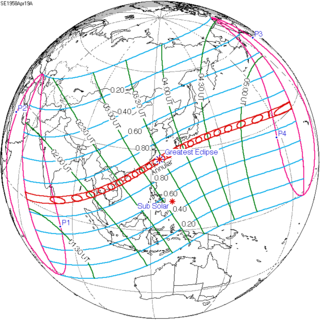| Solar eclipse of April 19, 1958 | |
|---|---|
| Type of eclipse | |
| Nature | Annular |
| Gamma | 0.275 |
| Magnitude | 0.9408 |
| Maximum eclipse | |
| Duration | 427 s (7 min 7 s) |
| Coordinates | 26°30′N 123°36′E / 26.5°N 123.6°E |
| Max. width of band | 228 km (142 mi) |
| Times (UTC) | |
| Greatest eclipse | 3:27:17 |
| References | |
| Saros | 128 (55 of 73) |
| Catalog # (SE5000) | 9416 |
An annular solar eclipse occurred at the Moon's descending node of orbit on Saturday, April 19, 1958,[1] with a magnitude of 0.9408. A solar eclipse occurs when the Moon passes between Earth and the Sun, thereby totally or partly obscuring the image of the Sun for a viewer on Earth. An annular solar eclipse occurs when the Moon's apparent diameter is smaller than the Sun's, blocking most of the Sun's light and causing the Sun to look like an annulus (ring). An annular eclipse appears as a partial eclipse over a region of the Earth thousands of kilometres wide. Occurring about 2.2 days after apogee (on April 16, 1958, at 22:40 UTC), the Moon's apparent diameter was smaller.[2]
Annularity was visible in the Maldives, Nicobar Islands, Burma, Thailand including the capital city Bangkok, Cambodia, Laos, North Vietnam and South Vietnam (now belonging to Vietnam), China, British Hong Kong, Taiwan, Ryukyu Islands and Japan. Places east of International Date line witnessed the eclipse on April 18 (Friday). A partial eclipse was visible for most of Asia.
This was the last of four central solar eclipses visible from Bangkok from 1948 to 1958, where it is extremely rare for a large city to witness four central solar eclipses within 10 years.
- ^ "April 19, 1958 Annular Solar Eclipse". timeanddate. Retrieved 6 August 2024.
- ^ "Moon Distances for London, United Kingdom, England". timeanddate. Retrieved 6 August 2024.
